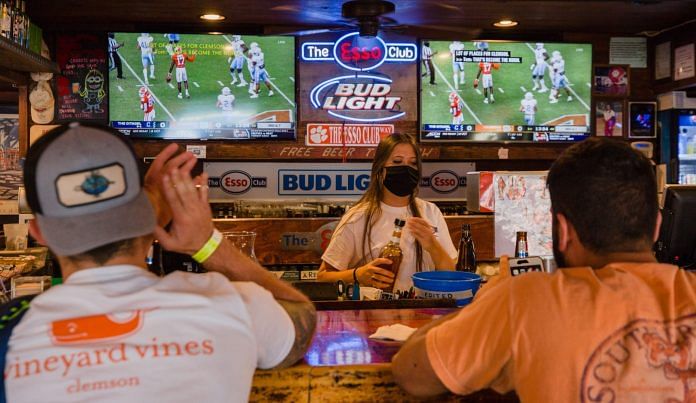Across the U.S., the reopening of college campuses is fast becoming a new public-health crisis. The arrival of students for the start of the fall semester has caused Covid-19 infections to spike in college towns from Chapel Hill, North Carolina, to Chico, California. Of counties where college students are at least 10% of the population, half have seen Covid cases hit their highest-ever levels in the past month.
Given lack of guidance from federal and state officials and the inadequacy of the U.S.’s testing system, mounting infections among college students were all too likely. College administrators failed to anticipate the scale of the outbreaks or develop plans for containing them. To protect students, faculty and residents of surrounding communities, colleges now need to curtail student activities and move classes online.
About half of the country’s colleges, including many of the biggest public universities, have tried to resume some form of in-person instruction. Officials said failing to do so would harm students, cause enrollments to plunge and decimate local businesses. But without adequate capacity to test and trace, schools had to rely on students policing themselves. Unfortunately, too many students have proved unwilling to behave responsibly and resist the lure of bars and parties — a breathtaking lack of awareness that has come with significant costs for schools and the communities that surround them. Even universities that are testing large numbers and isolating the sick have seen hundreds of cases within weeks of resuming classes.
The response has been chaotic. Some schools have canceled in-person classes for the rest of the semester, while others have suspended them, with plans to resume face-to-face instruction if cases subside. The University of Wisconsin issued a shelter-in-place order to students even as it announced plans to bring back football. At the University of Alabama, which has more than 1,000 infections, students placed in “isolation dorms” have said they’ve received virtually no guidance or supervision. Monitoring students living off-campus is even harder; at Miami University in Ohio, five housemates who’d tested positive were fined for throwing a party. Faced with tracing contacts and enforcing quarantines, several large universities have told students to go home — perhaps causing the virus to spread even further.
Colleges should prioritize containing outbreaks — through frequent testing of asymptomatic students, rigorous contact tracing and greater use of mass-testing techniques such as wastewater testing. While preventing undergraduates from socializing is impossible, administrators can still insist on closer supervision. Rather than sending them home, colleges should keep students housed on campus or in nearby apartments, until health officials can verify that they pose minimal risk to their families. Local officials can help by expanding testing sites, helping colleges collect data, and keeping bars and cafes closed until infections decline.
As for the learning itself, virtual classes are undeniably inferior to the real thing. College students, however, can manage online learning better than grade-schoolers. Allowing the virus to spread beyond college campuses will make it more difficult to reopen schools safely for younger children — causing far more social and economic harm than moving college classes online.
One more thing. Schools that scrap in-person classes should refund students a portion of their tuition, or provide credit toward future costs. Forgoing revenue will be painful when many schools are already squeezed, but a modest discount on the exorbitant cost of college would help restore confidence in a system that, so far, has acquitted itself poorly.-Bloomberg
Also read: These countries think their govt did a good job of dealing with the Covid pandemic






